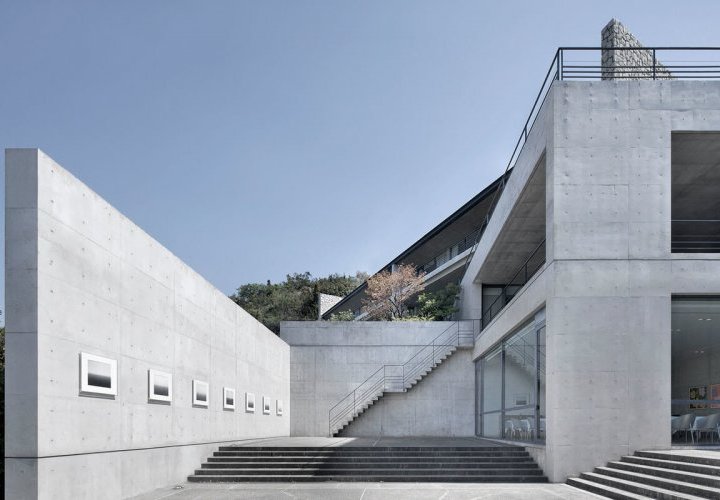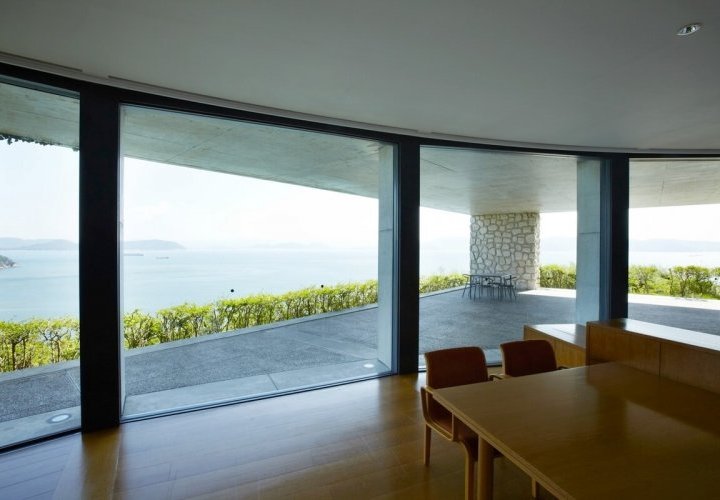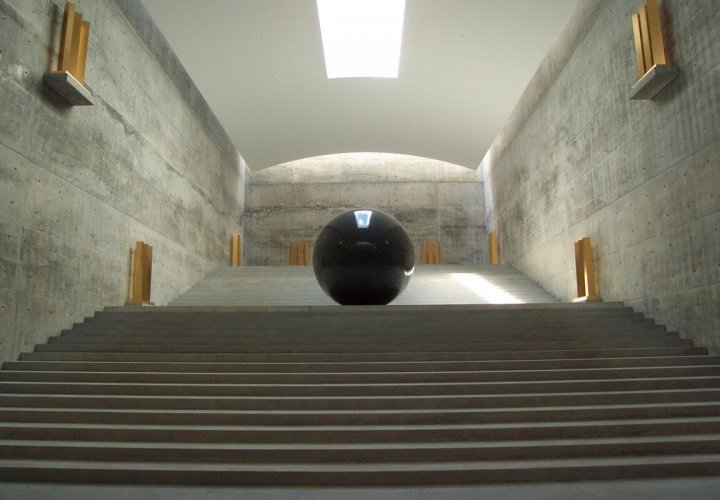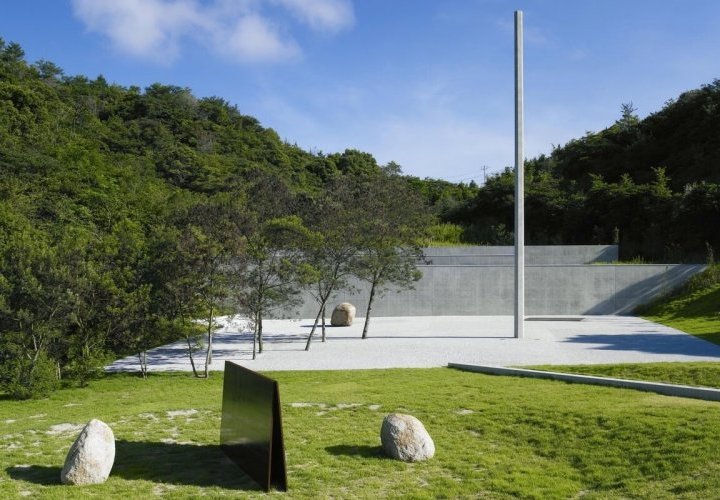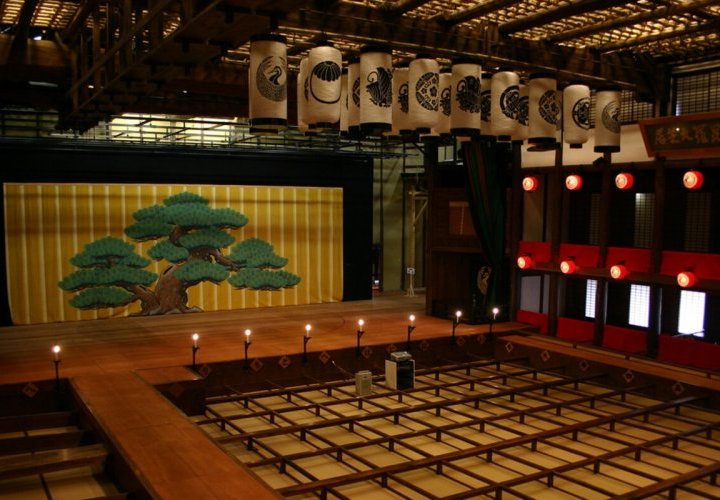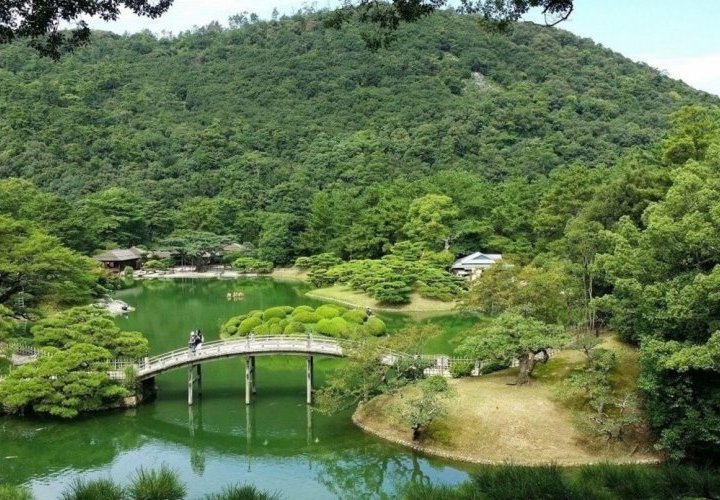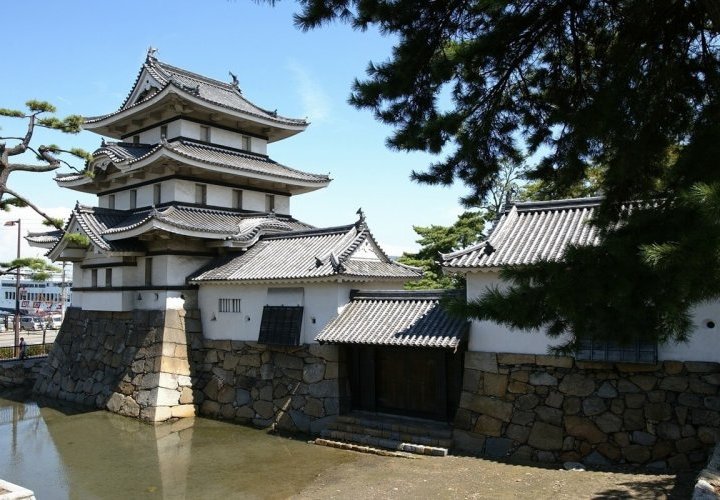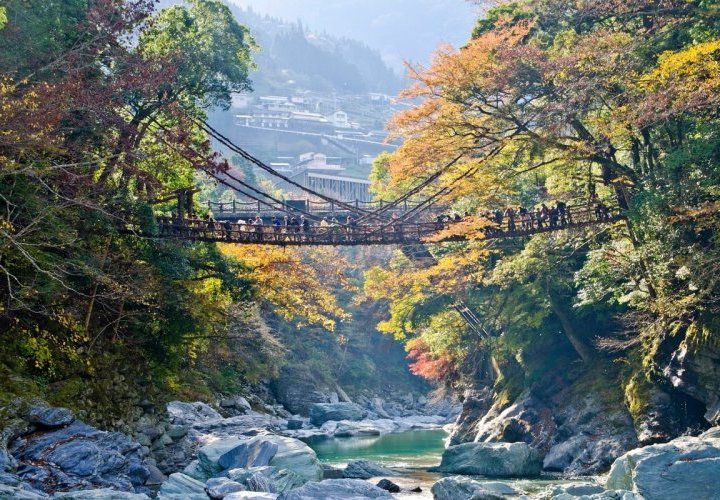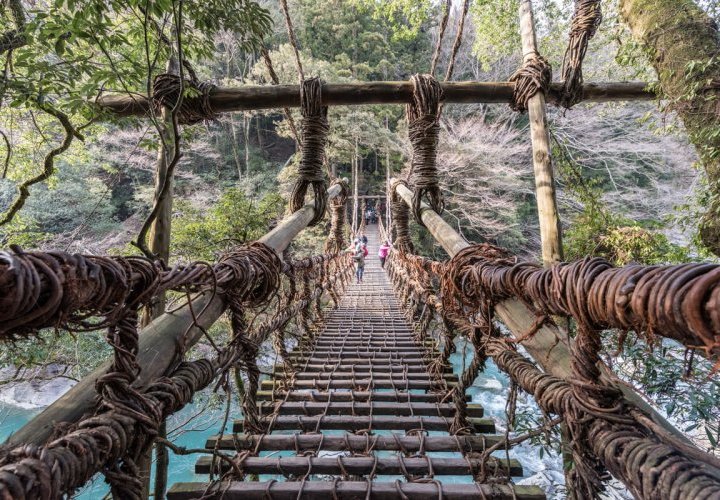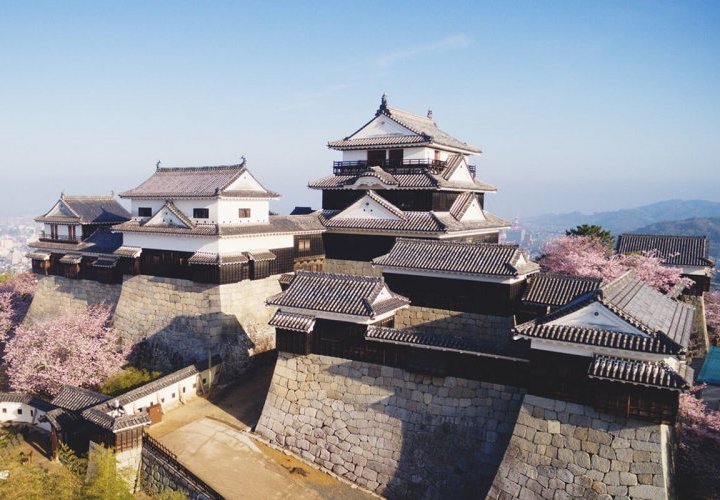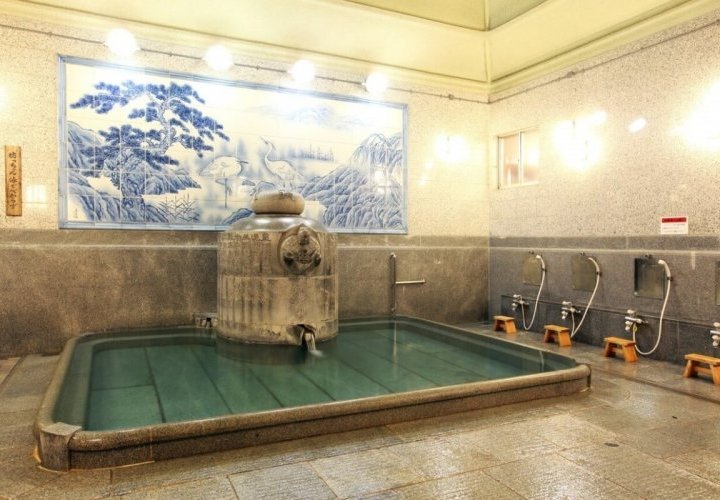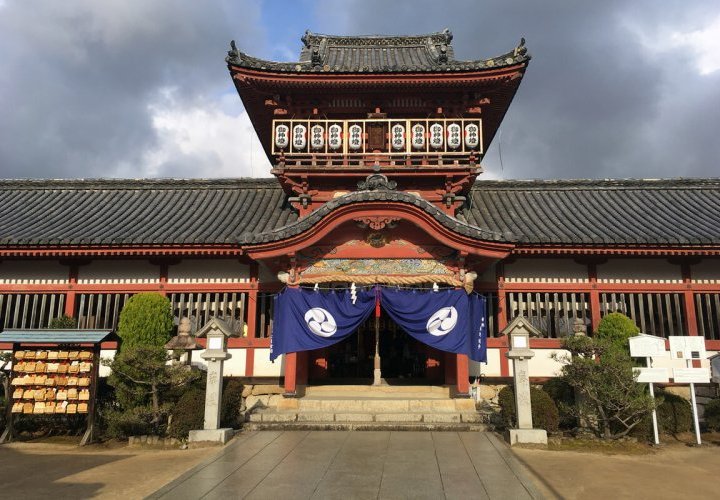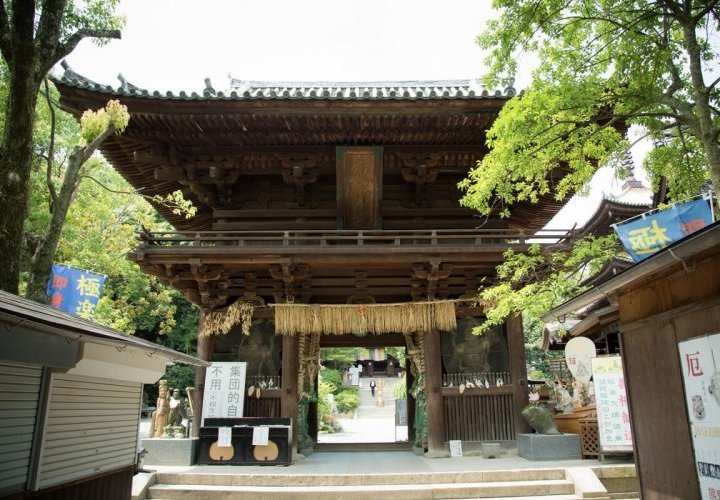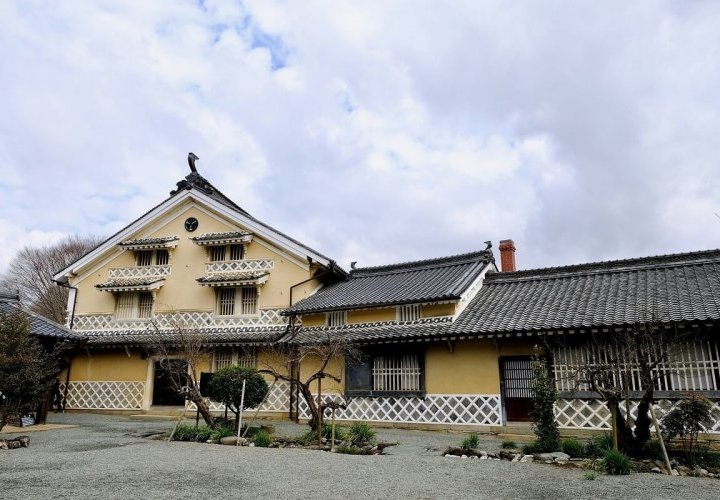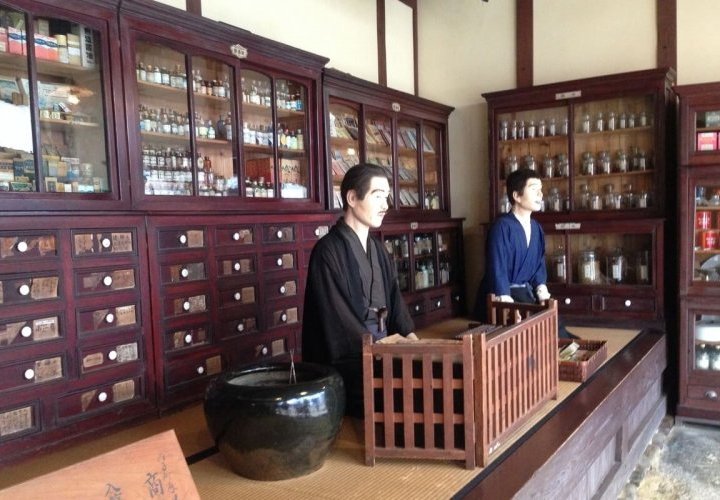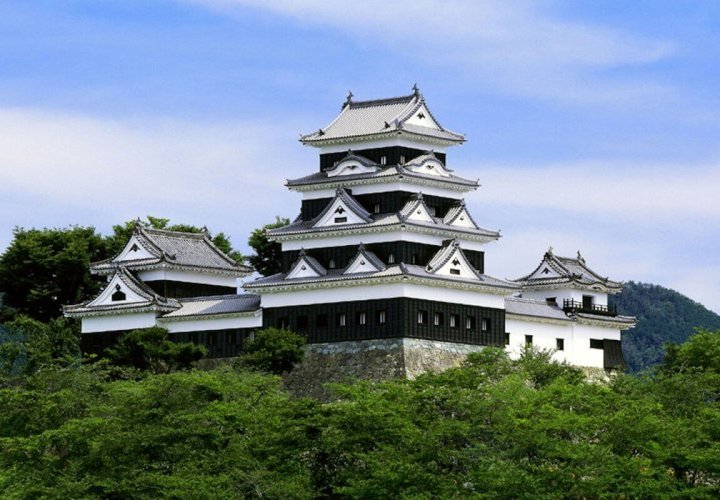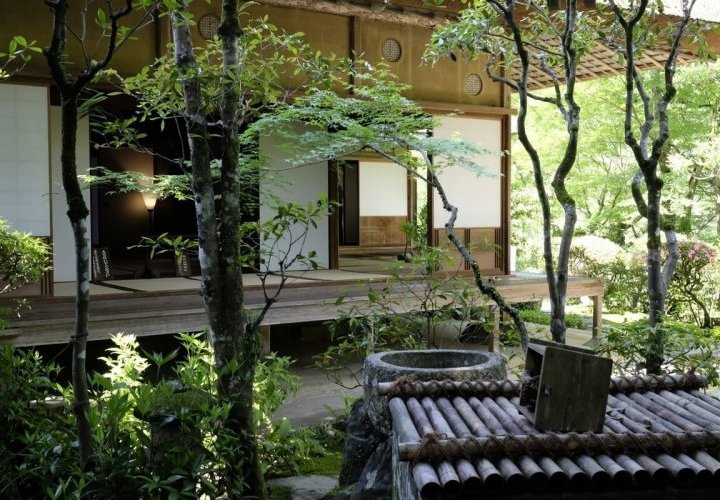Located south of Honshu and northeast of Kyushu, Shikoku is the smallest of the four main islands of Japan (18,783 square kilometres). It is 225 km long and between 50 and 150 km wide and has a population of around 3.8 million inhabitants. Unlike the other three main islands of Japan, Shikoku has no volcanoes. Mountains that run east and west divide Shikoku Island into a narrow northern sub-region facing the Seto Inland Sea, and a southern part fronting the Pacific Ocean. Mount Ishizuchi in Ehime is the highest mountain on the island (1,982 m). Shikoku region consists of four prefectures: Ehime, Kagawa, Kochi, and Tokushima. With a population of 509,835 inhabitants, Matsuyama is the largest city in Shikoku and the capital of Ehime Prefecture.
Naoshima Island is a small island in the Seto Inland Sea of Japan, more
Naoshima Island is a small island in the Seto Inland Sea of Japan, more
Kagawa Prefecture, known for its contemporary art galleries, museums and outdoor sculptures. The island town with its relaxing atmosphere, sandy beaches and sunny weather is the perfect getaway from Japan’s large urban areas such as Tokyo and Osaka. The island is populated by only 3,000 inhabitants and was revitalised by the opening of the Benesse House Museum in the early '90s.
TOURIST ATTRACTIONS IN NAOSHIMA
Benesse House
The Benesse House complex consists of four buildings designed by the well-known Japanese architect Ando Tadao: the Museum, Oval, Park and Beach, each of them featuring its own unique artwork and guest rooms. The modern art Museum located on a hill overlooking the sea is the main attraction of the Benesse House. It displays works created by different artists from both Japan and abroad, inspired by the natural surroundings of Naoshima and the architecture on the island. Many art museums have opened and sculptures appeared across the island including Yayoi Kusama’s iconic yellow pumpkin (known as the Naoshima pumpkin) and Benesse’s museums such as the Chichu Art Museum and Lee Ufan Museum.
Chichu Art Museum
Chichu Art Museum is a unique modern art museum built in 2004 as a site rethinking the relationship between nature and people. The museum building, designed by Ando Tadao, is mostly located underground in order to avoid affecting the beautiful natural scenery of the Seto Inland Sea. It holds a rather small collection of artworks by Claude Monet (paintings from the Water Lilies series), James Turrell, who uses light as an art and works by Walter De Maria, which are on permanent display in this building. Despite being mostly subterranean, the museum has plenty of natural light that changes the appearance of the artworks and the ambience of the space itself depending on the daytime and during the four seasons of the year. The entire art space, containing a sphere with a diameter of 2.2 metres and 27 gilded wooden geometric forms, created under the direction of Walter De Maria as an artwork, can be experienced by viewers under the natural light coming in from the ceiling, producing dramatic changes in the illumination of the room, depending on the hour. James Turrell’s Open Sky installation can be viewed at any time during museum open hours, but it allows you to enjoy a special 45-minute sunset viewing.
Lee Ufan Museum
Lee Ufan Museum features works by the Korean contemporary artist Lee Ufan, who was born in Korea but has been working and teaching in Japan. The museum building was designed by the Japanese architect Ando Tadao and mixes geometrically shaped reinforced concrete with nature and open spaces that accentuate the artwork displayed within it. The museum offers a quiet space where nature, architecture and art come in resonance with each other, inviting visitors to peaceful contemplation in a society overflowing with material goods.
TOURIST ATTRACTIONS IN NAOSHIMA
Benesse House
The Benesse House complex consists of four buildings designed by the well-known Japanese architect Ando Tadao: the Museum, Oval, Park and Beach, each of them featuring its own unique artwork and guest rooms. The modern art Museum located on a hill overlooking the sea is the main attraction of the Benesse House. It displays works created by different artists from both Japan and abroad, inspired by the natural surroundings of Naoshima and the architecture on the island. Many art museums have opened and sculptures appeared across the island including Yayoi Kusama’s iconic yellow pumpkin (known as the Naoshima pumpkin) and Benesse’s museums such as the Chichu Art Museum and Lee Ufan Museum.
Chichu Art Museum
Chichu Art Museum is a unique modern art museum built in 2004 as a site rethinking the relationship between nature and people. The museum building, designed by Ando Tadao, is mostly located underground in order to avoid affecting the beautiful natural scenery of the Seto Inland Sea. It holds a rather small collection of artworks by Claude Monet (paintings from the Water Lilies series), James Turrell, who uses light as an art and works by Walter De Maria, which are on permanent display in this building. Despite being mostly subterranean, the museum has plenty of natural light that changes the appearance of the artworks and the ambience of the space itself depending on the daytime and during the four seasons of the year. The entire art space, containing a sphere with a diameter of 2.2 metres and 27 gilded wooden geometric forms, created under the direction of Walter De Maria as an artwork, can be experienced by viewers under the natural light coming in from the ceiling, producing dramatic changes in the illumination of the room, depending on the hour. James Turrell’s Open Sky installation can be viewed at any time during museum open hours, but it allows you to enjoy a special 45-minute sunset viewing.
Lee Ufan Museum
Lee Ufan Museum features works by the Korean contemporary artist Lee Ufan, who was born in Korea but has been working and teaching in Japan. The museum building was designed by the Japanese architect Ando Tadao and mixes geometrically shaped reinforced concrete with nature and open spaces that accentuate the artwork displayed within it. The museum offers a quiet space where nature, architecture and art come in resonance with each other, inviting visitors to peaceful contemplation in a society overflowing with material goods.
Kotohira is a small town in Kagawa Prefecture, best known as the site of the most popular shrine in Shikoku, Kotohiragu Shrine (known as Kompirasan). The town was named after an ancient marine god named Kotohira-gu and has a total area 8.46 square kilometres. Kotohira also features the oldest surviving Kabuki playhouse, the Kanamaruza Theatre.
TOURIST ATTRACTIONS IN KOTOHIRA
Kompirasan Shrine
Kompirasan, formally known as Kotohiragu, is the main shrine of multiple Kompira shrines dedicated to sailors and seafaring that are found around Japan. Located at 521 metres halfway to the top of Mount Zozu, the approach to Kompirasan inner shrine is an arduous series of 1,368 stone steps. Over a long time, more
TOURIST ATTRACTIONS IN KOTOHIRA
Kompirasan Shrine
Kompirasan, formally known as Kotohiragu, is the main shrine of multiple Kompira shrines dedicated to sailors and seafaring that are found around Japan. Located at 521 metres halfway to the top of Mount Zozu, the approach to Kompirasan inner shrine is an arduous series of 1,368 stone steps. Over a long time, more
Kompirasan had been seen a mixture between a Shinto shrine and a Buddhist temple, until it was officially declared a shrine at the beginning of the Meiji period.
Since the Muromachi period, Kompirasan has become a highly popular site visited by pilgrims from across the country. On the way to the shrine there is a shopping arcade filled with souvenir shops and restaurants, a sake museum and stones with the names of donors carved in kanji.
Kanamaruza Theatre
Kanamaruza Theatre was built in Kotohira in 1835 and is the oldest surviving, complete kabuki playhouse in Japan. From time to time, Kabuki plays are still performed, featuring some of the most popular kabuki stars of the country. When no shows take place, the theatre is open to visitors who can explore Kanamaruza’s audience hall, stage and dressing rooms. In 1970, the theatre was designated an Important Cultural Property by the Agency for Cultural Affairs of the national government. In 1976, the theatre was restored to its Edo period appearance and moved some 200 metres to a new location.
Since the Muromachi period, Kompirasan has become a highly popular site visited by pilgrims from across the country. On the way to the shrine there is a shopping arcade filled with souvenir shops and restaurants, a sake museum and stones with the names of donors carved in kanji.
Kanamaruza Theatre
Kanamaruza Theatre was built in Kotohira in 1835 and is the oldest surviving, complete kabuki playhouse in Japan. From time to time, Kabuki plays are still performed, featuring some of the most popular kabuki stars of the country. When no shows take place, the theatre is open to visitors who can explore Kanamaruza’s audience hall, stage and dressing rooms. In 1970, the theatre was designated an Important Cultural Property by the Agency for Cultural Affairs of the national government. In 1976, the theatre was restored to its Edo period appearance and moved some 200 metres to a new location.
Located on the island of Shikoku, Takamatsu city is the capital of Kagawa, the smallest prefecture of Japan. The port of the city used to be the main entry point to Shikoku Island until 1988, when the Seto Ohashi Bridge was opened. Takamatsu had been a political and economic centre in the area since the Edo period when the Matsudaira clan, relatives of the Tokugawa Shogun, made it the capital of their han. The ruling clan also built Ritsurin Koen, one of the most beautiful gardens of Japan. The city was officially founded on February 15, 1890 and has a total area of 375.41 square kilometres and an estimated population of 419,429 inhabitants.
TOURIST ATTRACTIONS IN TAKAMATSU
Ritsurin Garden
Ritsurin Garden (Ritsurin Koen) is one of the most famous historical gardens in Japan and was built by the local feudal lords during the early Edo Period. more
TOURIST ATTRACTIONS IN TAKAMATSU
Ritsurin Garden
Ritsurin Garden (Ritsurin Koen) is one of the most famous historical gardens in Japan and was built by the local feudal lords during the early Edo Period. more
It is considered one of the best gardens in Japan and features many ponds, hills, footpaths, historic trees and beautiful pavilions that offer a beautiful view of the garden and the surrounding scenery, most notably Mt. Shiun, which serves as a wonderful background. The garden has a number of facilities including a folk museum, a tea house, shops and a few rest houses where you can take a break. The construction of the garden began in 1625 by the feudal lord of Takamatsu in Sanuki Province, Ikoma Takatoshi and was completed by the Fifth Lord Yoritaka in 1745, after 100 years of improvements and extensions made by the successive lords. The garden covers 750,000 square metres and deserves a spot on the list of the most beautiful gardens of Japan.
Takamatsu Castle
Takamatsu Castle, also known as Tamamo Castle, was built in 1590 by Ikoma Chikamasa, the first feudal lord of Takamatsu Domain. It is one of the few Japanese castles built along a waterfront, being known as one of the three Mizujiro or “Water Castles” in Japan, along with Imabari Castle in Ehime Prefecture and Nakatsu Castle in Oita Prefecture. During the Meiji period, the keep of the castle was destroyed and the first step to reconstruct it was achieved in 2013, when the foundation of the castle tower was restored after many years of work. At the centre of the castle park, you will see the Hiunkaku building that was built in 1917 as a residence and governmental office and is used today as an exhibition space and a community hall where tea ceremony and flower arrangement classes take place.
SIDE TRIPS FROM TAKAMATSU
Iya Valley
Located in the heart of Shikoku, the Iya Valley is a relatively remote, unexplored spot in western Tokushima Prefecture. The valley features steep mountain slopes, deep rocky gorges and several vine bridges. In the past, the area used to have 13 kazurabashi (vine suspension bridge), but only some of them preserved to this day and remain some of the most popular attractions of the area. You can start with Oku Iya Niju Kazura Double-Vine Bridge and then cross the Iya Kazurabashi Bridge, which is 45 metres long, 2 metres wide and 14 metres above the Iya River.
The Iya Valley is commonly divided into two areas: Nishi Iya (West Iya), which is around the entrance to the valley and is slightly more developed and more accessible by bus and Oku Iya (Inner Iya or East Iya), which lies further back into the valley and is difficult to reach without a rental car. Nishi Iya includes such attractions as the Manikin Peeing Boy Statue, the open-air baths located alongside the flowing Iya River and the Iya Kazurabashi Bridge. You will find true serenity while relaxing in an open-air bath tucked deep within the valley, accompanied only by the singing of birds and the sound of wind rustling in the trees. This remoteness draws visitors who look for unexplored spots to the area, offering them the possibility to experience a traditional, rural culture that is difficult to find in modern Japan.
Oku Iya area features such attractions as the Higashi Iya History and Folk Museum (displays tools, household items, clothes, and other traditional items of the region), the Samurai House (a former home of local village leaders) and the Oku-Iya Kazurabashi Bridges that are two vine bridges, Otto no Hashi (husband bridge) and Tsuma no Hashi (wife bridge) that stand side by side deep in the Iya Valley near Mount Tsurugi. The 1955-metre high mountain lies at the eastern end of the Iya Valley. Mount Tsurugi is the second tallest mountain on Shikoku Island, being at the same time one of top 100 Famous Japanese Mountains and a centre of Shugendo, a Japanese folk religion based on mountain worship. It is a popular hiking destination and there is a chairlift that will take you most of the way up the mountain to a station near the summit. From there, it will take about 30 minutes to hike the most direct route to the peak, where you will find a shrine, mountain huts, weather towers, and wooden boardwalks that lead to various viewpoints.
Takamatsu Castle
Takamatsu Castle, also known as Tamamo Castle, was built in 1590 by Ikoma Chikamasa, the first feudal lord of Takamatsu Domain. It is one of the few Japanese castles built along a waterfront, being known as one of the three Mizujiro or “Water Castles” in Japan, along with Imabari Castle in Ehime Prefecture and Nakatsu Castle in Oita Prefecture. During the Meiji period, the keep of the castle was destroyed and the first step to reconstruct it was achieved in 2013, when the foundation of the castle tower was restored after many years of work. At the centre of the castle park, you will see the Hiunkaku building that was built in 1917 as a residence and governmental office and is used today as an exhibition space and a community hall where tea ceremony and flower arrangement classes take place.
SIDE TRIPS FROM TAKAMATSU
Iya Valley
Located in the heart of Shikoku, the Iya Valley is a relatively remote, unexplored spot in western Tokushima Prefecture. The valley features steep mountain slopes, deep rocky gorges and several vine bridges. In the past, the area used to have 13 kazurabashi (vine suspension bridge), but only some of them preserved to this day and remain some of the most popular attractions of the area. You can start with Oku Iya Niju Kazura Double-Vine Bridge and then cross the Iya Kazurabashi Bridge, which is 45 metres long, 2 metres wide and 14 metres above the Iya River.
The Iya Valley is commonly divided into two areas: Nishi Iya (West Iya), which is around the entrance to the valley and is slightly more developed and more accessible by bus and Oku Iya (Inner Iya or East Iya), which lies further back into the valley and is difficult to reach without a rental car. Nishi Iya includes such attractions as the Manikin Peeing Boy Statue, the open-air baths located alongside the flowing Iya River and the Iya Kazurabashi Bridge. You will find true serenity while relaxing in an open-air bath tucked deep within the valley, accompanied only by the singing of birds and the sound of wind rustling in the trees. This remoteness draws visitors who look for unexplored spots to the area, offering them the possibility to experience a traditional, rural culture that is difficult to find in modern Japan.
Oku Iya area features such attractions as the Higashi Iya History and Folk Museum (displays tools, household items, clothes, and other traditional items of the region), the Samurai House (a former home of local village leaders) and the Oku-Iya Kazurabashi Bridges that are two vine bridges, Otto no Hashi (husband bridge) and Tsuma no Hashi (wife bridge) that stand side by side deep in the Iya Valley near Mount Tsurugi. The 1955-metre high mountain lies at the eastern end of the Iya Valley. Mount Tsurugi is the second tallest mountain on Shikoku Island, being at the same time one of top 100 Famous Japanese Mountains and a centre of Shugendo, a Japanese folk religion based on mountain worship. It is a popular hiking destination and there is a chairlift that will take you most of the way up the mountain to a station near the summit. From there, it will take about 30 minutes to hike the most direct route to the peak, where you will find a shrine, mountain huts, weather towers, and wooden boardwalks that lead to various viewpoints.
Matsuyama is the capital city of Ehime Prefecture and the largest city on Shikoku Island. It has a population of 509,835 inhabitants and is located on the northeastern portion of the Dogo Plain. The city is known for Matsuyama Castle, a beautiful, original castle located in the centre of the city, Dogo Onsen, one of the oldest hot spring resorts in Japan and eight of the eighty-eight temples included in Shikoku 88 Temple Pilgrimage Route.
TOURIST ATTRACTIONS IN MATSUYAMA
Matsuyama Castle
Matsuyama Castle was built between 1602 and 1628 on Mount Katsuyama (132 metres) and is one of Japan’s twelve “original castles” (castles that have survived the post-feudal era since 1868 intact). The castle’s hilltop allows visitors to enjoy a bird’s eye view of the city and a glimpse of the Seto Inland Sea. more
TOURIST ATTRACTIONS IN MATSUYAMA
Matsuyama Castle
Matsuyama Castle was built between 1602 and 1628 on Mount Katsuyama (132 metres) and is one of Japan’s twelve “original castles” (castles that have survived the post-feudal era since 1868 intact). The castle’s hilltop allows visitors to enjoy a bird’s eye view of the city and a glimpse of the Seto Inland Sea. more
There are two possibilities to access the castle: either by riding a chairlift on a ropeway or by climbing up the hill (about 15 minutes) from the base of the ropeway station or from Ninomaru Garden. The castle becomes a lovely cherry blossom spot from late March to early April, when about 200 cherry trees bloom beautifully on the castle grounds.
Dogo Onsen
Located to the east of central Matsuyama, Dogo Onsen is one of the oldest hot springs in Japan. The hot springs are mentioned in the Man'yoshu (written c. 759) and, according to the legend, Prince Shotoku (574–622) used to bath in the waters. The area is popular among tourists due to its beautiful bathhouse Dogo Onsen Honkan and many ryokan. Dogo Onsen Honkan is a wooden public bathhouse built in 1894, whose interior is a maze of stairways, passages and rooms.
The Honkan has two indoor old-fashioned public baths made of stone: Kami no Yu (Bath of the Gods), the larger public bath separated into two baths for men and one for women and Tama no Yu (Bath of the Spirits), the smaller, more noble and less crowded bath separated into two baths for men and one for women.
Dogo Onsen also has a bathroom, called Yushinden, especially reserved for the Imperial Family. It was built in 1899 and includes a decorated room with a coffered ceiling, and a bath and toilet for the emperor's exclusive use. The area also contains other attractions such as a shopping arcade, interesting temples and shrines, the secondary bathhouse Asuka no Yu, Dogo Park and a museum about Masaoka Shiki.
Ishiteji Temple
Ishiteji Temple is located near Dogo Onsen and is the most famous temple of Matsuyama city. It is number 51 of the 88 temples included in Shikoku 88 Temple Pilgrimage Route. Its name means “stone hand temple” and 7 of its structures including Niomon Gate, the main hall and pagoda have been designated National Treasures or Important Cultural Properties. Ishiteji hosts a curious looking inner temple connected to the main grounds via a cave, which is about 200 metres long and houses many Buddhist statues, carvings and drawings.
Isaniwa Shrine
Located about 200 metres east of Dogo Onsen Station, Isaniwa Shrine consists of two halls, whose roofs are connected with each other, essentially forming a single building. It is said that the shrine was founded on the place where Emperor Chuai and Empress Jingu bathed at Dogo Onsen. In the 14th century, the Kono clan moved the shrine to its present location. Isaniwa Shrine was built in the traditional Hachiman architectural style and features sheltered corridors, vermillion pillars and a tall flight of stairs leading to it.
Dogo Onsen
Located to the east of central Matsuyama, Dogo Onsen is one of the oldest hot springs in Japan. The hot springs are mentioned in the Man'yoshu (written c. 759) and, according to the legend, Prince Shotoku (574–622) used to bath in the waters. The area is popular among tourists due to its beautiful bathhouse Dogo Onsen Honkan and many ryokan. Dogo Onsen Honkan is a wooden public bathhouse built in 1894, whose interior is a maze of stairways, passages and rooms.
The Honkan has two indoor old-fashioned public baths made of stone: Kami no Yu (Bath of the Gods), the larger public bath separated into two baths for men and one for women and Tama no Yu (Bath of the Spirits), the smaller, more noble and less crowded bath separated into two baths for men and one for women.
Dogo Onsen also has a bathroom, called Yushinden, especially reserved for the Imperial Family. It was built in 1899 and includes a decorated room with a coffered ceiling, and a bath and toilet for the emperor's exclusive use. The area also contains other attractions such as a shopping arcade, interesting temples and shrines, the secondary bathhouse Asuka no Yu, Dogo Park and a museum about Masaoka Shiki.
Ishiteji Temple
Ishiteji Temple is located near Dogo Onsen and is the most famous temple of Matsuyama city. It is number 51 of the 88 temples included in Shikoku 88 Temple Pilgrimage Route. Its name means “stone hand temple” and 7 of its structures including Niomon Gate, the main hall and pagoda have been designated National Treasures or Important Cultural Properties. Ishiteji hosts a curious looking inner temple connected to the main grounds via a cave, which is about 200 metres long and houses many Buddhist statues, carvings and drawings.
Isaniwa Shrine
Located about 200 metres east of Dogo Onsen Station, Isaniwa Shrine consists of two halls, whose roofs are connected with each other, essentially forming a single building. It is said that the shrine was founded on the place where Emperor Chuai and Empress Jingu bathed at Dogo Onsen. In the 14th century, the Kono clan moved the shrine to its present location. Isaniwa Shrine was built in the traditional Hachiman architectural style and features sheltered corridors, vermillion pillars and a tall flight of stairs leading to it.
Uchiko is a town located in Ehime Prefecture, about 42 km southwest of Matsuyama city. The town was a prosperous centre of wax and paper production from the end of the Edo period (1603–1867) to the end of the Meiji period (1868–1912). Yokaichi district looks just as it did over 100 years ago, when wealth and prosperity came to Uchiko through its wax trade. One of the main attractions of Uchiko, the Kamihaga Residence located in the district, still explores this historical industry. Another attraction of the town, Uchiko-za, is a full-scale kabuki theatre found outside of the old district. The town has an area of 299.50 square kilometres and an estimated population of 16,172 inhabitants.
TOURIST ATTRACTIONS IN UCHIKO
Uchiko-za Theatre
Uchiko-za is a kabuki theatre in the centre of Uchiko that was built in 1916 and continues to occasionally host various events, more
TOURIST ATTRACTIONS IN UCHIKO
Uchiko-za Theatre
Uchiko-za is a kabuki theatre in the centre of Uchiko that was built in 1916 and continues to occasionally host various events, more
including Kabuki and Bunraku (traditional puppet show) performances. In 1985, the theatre was restored to its original appearance and is considered a showpiece of Japanese culture and architecture. You can enter Uchiko-za, explore the trap doors and hidden passageways around the stage and examine the mechanics of such stage choreography.
Yokaichi Old Town
Yokaichi Old Town is a historical district that features a 600-metre long preserved street of about 90 historical buildings including personal residences and warehouses of the wealthy merchants. In the late 19th century, the name of Uchiko became synonymous with high quality white wax production and the wealthy local merchants began to build new buildings, resulting in beautiful streets lined with large, stylish houses. Two of these buildings, Kamihaga Residence and Machiya Museum (shows how a typical merchant’s residence looked like during the Edo Period), are open to the public as museums.
Kamihaga Residence
The Kamihaga Residence is one of the most interesting buildings in Uchiko, offering a glimpse of how the town prospered through its wax industry. It was built in 1894 by Kamihaga family (a branch of the Honhaga household), one of the most influential families in Uchiko, who established the production of wax in Uchiko and thus, became very wealthy and powerful. The large building complex consists of a spacious Meiji Period residence and a museum about the wax industry of Uchiko and was designated as an Important Cultural Property.
Uchiko History Museum
Uchiko History Museum is located along the main street, outside of Yokaichi Old Town district, and displays life-sized, automated figures arranged to show how residents of the town lived in the 19th and 20th centuries. It is also known as the Museum of Commercial and Domestic Life and shows how the more stylish town houses of local merchant families with beautiful tatami rooms with sliding doors and painted screens looked like.
Yokaichi Old Town
Yokaichi Old Town is a historical district that features a 600-metre long preserved street of about 90 historical buildings including personal residences and warehouses of the wealthy merchants. In the late 19th century, the name of Uchiko became synonymous with high quality white wax production and the wealthy local merchants began to build new buildings, resulting in beautiful streets lined with large, stylish houses. Two of these buildings, Kamihaga Residence and Machiya Museum (shows how a typical merchant’s residence looked like during the Edo Period), are open to the public as museums.
Kamihaga Residence
The Kamihaga Residence is one of the most interesting buildings in Uchiko, offering a glimpse of how the town prospered through its wax industry. It was built in 1894 by Kamihaga family (a branch of the Honhaga household), one of the most influential families in Uchiko, who established the production of wax in Uchiko and thus, became very wealthy and powerful. The large building complex consists of a spacious Meiji Period residence and a museum about the wax industry of Uchiko and was designated as an Important Cultural Property.
Uchiko History Museum
Uchiko History Museum is located along the main street, outside of Yokaichi Old Town district, and displays life-sized, automated figures arranged to show how residents of the town lived in the 19th and 20th centuries. It is also known as the Museum of Commercial and Domestic Life and shows how the more stylish town houses of local merchant families with beautiful tatami rooms with sliding doors and painted screens looked like.
Ozu city is located in Ehime Prefecture on the western coast of Shikoku and emerged during the Edo Period (1603-1867) as a castle town. The city developed as the political centre of Ozu domain and a section of the old town remains today with nostalgic alleys and old-fashioned houses. The picturesque Hijikawa River flows through the centre of Ozu city, allowing you to see cormorant fishing (ukai) in the summer. Ozu Castle that stands proudly in the city centre and Garyu Sanso Villa that stands just east of the old town are important tourist attractions of the city.
TOURIST ATTRACTIONS IN OZU
Ozu Castle
Ozu Castle, also known as Jizogatake Castle, stands on a hill by the Hijikawa River in Ozu city. more
TOURIST ATTRACTIONS IN OZU
Ozu Castle
Ozu Castle, also known as Jizogatake Castle, stands on a hill by the Hijikawa River in Ozu city. more
The castle has its origins in the 1300s and was rebuilt several times over the years. In 1888, the deteriorated castle’s keep was demolished for being accurately reconstructed in 2004. An interesting feature that is quite rare among Japanese castles is the fact that the main keep of the castle is flanked by turrets on two sides, rather than having just a solitary standing main keep as many of the castles. Its two surrounding turrets (yagura), Koran Yagura and Daidokoro Yagura, were left intact when the castle’s keep was demolished. These two turrets built in the late Edo period, as well as the Owata and the Minami Sumi turrets were declared in 1957 Important Cultural Property in Japan. The castle buildings hold important exhibits about the history of Ozu city, maps about the local topography from past to present, models of the castle and displays of armours and other items belonging to past feudal lords.
Garyu Sanso Villa
Garyu Sanso is an outstanding villa built in the traditional sukiya style over an area of 10,000 square metres in the eastern part of Ozu’s old town. The villa was built around 1907 and it took around ten years to design the villa based on references from famous imperial villas in Kyoto and four years to construct it. This villa is one of the finest works of beautiful traditional Japanese architecture and has also been called Ozu Katsura Imperial Villa, being just as beautiful as the Katsura Imperial Villa of Kyoto. It has three main buildings (the main villa of Garyu-in and the tea houses of Chishi-an and Furo-an) that were built during the Meiji Era by the trader Torajiro Kawauchi in the traditional sukiya style and a Japanese garden that makes use of the surrounding beauty of the Hijikawa River. In 2011, Garyu Sanso Villa was listed as a 1-star site in the Michelin Green Guide Japan.
Garyu Sanso Villa
Garyu Sanso is an outstanding villa built in the traditional sukiya style over an area of 10,000 square metres in the eastern part of Ozu’s old town. The villa was built around 1907 and it took around ten years to design the villa based on references from famous imperial villas in Kyoto and four years to construct it. This villa is one of the finest works of beautiful traditional Japanese architecture and has also been called Ozu Katsura Imperial Villa, being just as beautiful as the Katsura Imperial Villa of Kyoto. It has three main buildings (the main villa of Garyu-in and the tea houses of Chishi-an and Furo-an) that were built during the Meiji Era by the trader Torajiro Kawauchi in the traditional sukiya style and a Japanese garden that makes use of the surrounding beauty of the Hijikawa River. In 2011, Garyu Sanso Villa was listed as a 1-star site in the Michelin Green Guide Japan.

